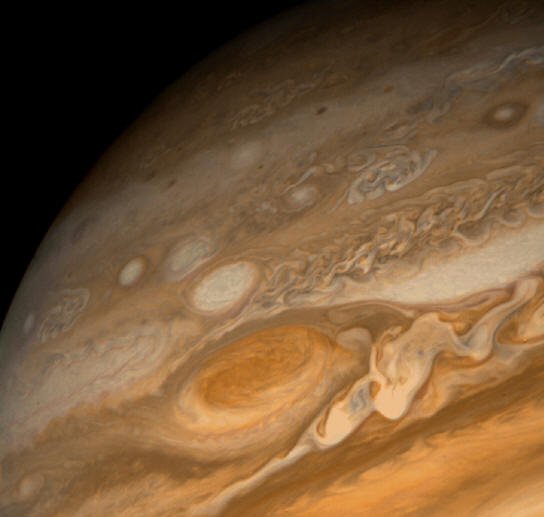|

The Great Red Spot on Jupiter
surrounded by smaller rotating
cells. Credit: Voyager 2/NASA-JPL.
Jupiter's Great Hot Spot
Sep
17, 2010
Is the famous gyre on Jupiter the
result of atmospheric convection?
The red spot in Jupiter's atmosphere
has persisted for more than 300
years, at least as long as there
have been telescopes on Earth able
to see it. The consensus opinion is
that it is a cyclonic storm driven
by rising heat from below. However,
exactly how it was formed and why it
has persisted for so long remain a
mystery.
The oval-shaped spot varies in
size, from approximately 19,500
kilometers long to over 39,000
kilometers, with a maximum width of
around 21,000 kilometers. In
comparison, Earth is 12,800
kilometers in diameter. Wind speeds
around its perimeter have been
measured at 635 kilometers per hour,
twice as fast as a terrestrial
tornado.
Planetary scientists are not sure
what causes its red color. In fact,
they are not sure why the gas giant
planets exhibit unique overall color
schemes. Optical instruments reveal
that Neptune has a green color,
Uranus a blue, Saturn a pale yellow,
and Jupiter a rusty red appearance.
A recent
announcement from the
European Southern Observatory (ESO)
in Paranal, Chile states that their
Very Large Telescope (among others)
has detected variations in the
temperature map of the spot.
Observations reveal a warmer region
at its center, corresponding to the
deepest red color. "Warm" is a
relative term in this case, though,
since the Great Red Spot's
temperature averages -160 Celsius.
ESO investigators contend that
the warmer areas in the center of
the spot's vortex are sufficient to
drive its rotation as well as to
turn that center a darker red than
the rest of the spot. The red
color's origin—whether from chemical
changes in the atmosphere or
upwelling of other materials from
below—requires further study.
From an Electric Universe
perspective, Jupiter's enigmatic
markings, especially the Great Red
Spot, could have a different origin
altogether. Rather than from
internally generated heat and
convection, Jupiter's turbulent
atmosphere might be receiving its
energy from an external source.
A
previous Picture of the
Day noted that gigantic "plasma
tornadoes," or flux tubes, have been
found entering Earth's magnetosphere
from space. The flux tubes were
discovered by the fleet of THEMIS
satellites when they flew through
the highly charged structures. The
tubes were rotating at more than 1.5
million kilometers per hour and
generating over 100,000 amps of
electric current flow.
What the THEMIS satellites
transected in space were multiply
twisted electromagnetic fields, the
characteristic signature of
Birkeland current filaments.
Electric fields, no matter how weak,
initiate electric currents that, in
turn, generate magnetic fields. The
fields interact with magnetic fields
generated by other currents, forming
twisted pairs of filaments named
after the one who originally
discovered them, Kristian Birkeland.
Birkeland currents follow magnetic
field lines and draw charged
material from their surroundings
with a force that can be 39 orders
of magnitude greater than gravity.
Perhaps what ESO astronomers are
witnessing is the influx of plasma
filaments into Jupiter's
electrically charged environment. In
the image accompanying
their press release, several bright
points surround the red spot in an
arc-shaped array. Below the spot is
another bright arc-shape, indicative
of increased infrared radiation
emissions.
Birkeland currents rotate around
each other, beginning as many
strands spinning around a common
center in pairs. At first, there
might be 56 filaments that merge
into 28, then 14, and so on. As more
current flows through the circuit,
the number of filaments reduces, but
each pair becomes more energetic.
Where Birkeland currents intersect,
z-pinch compression zones occur,
glowing brightly as the plasma
density increases, releasing
abundant thermal (and other)
radiation.
Rather than upwelling clouds of
warm gas, the spot is probably
rotating because external
electromagnetic fields are
influencing the atmosphere. The
Great Red Spot, as well as other
rotating vortices on Jupiter, could
be where Birkeland currents impinge
on the giant gas planet.
Stephen Smith
|







